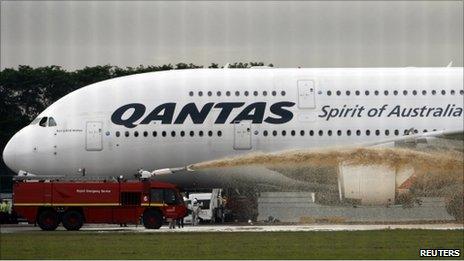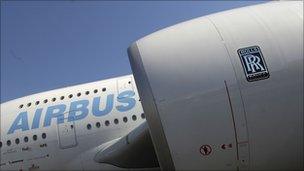Qantas emergency points spotlight at Airbus and Rolls-Royce
- Published

The cause of the engine failure that led to the emergency landing is not yet known
Engine trouble it may be, and investigators are on the case, but the focus is nevertheless also on the aircraft.
The grounding by Qantas of six A380 aircraft is just the latest in a string of problems to beset the largest passenger plane in the world.
It is "certainly the most serious incident that the A380 has experienced since it entered operations", according to Tom Ballantyne, who writes for Orient Aviation Magazine.
Ever since its launch at a grand ceremony at the Airbus headquarters in Toulouse almost six years ago, the Airbus A380 programme has struggled to overcome a series of complications.
Technical problems led to production slowing down, causing lengthy delivery delays and cost over-runs so large that some industry observers question whether the programme will ever make a profit for its European manufacturer.
And there have been operational problems, including an engine failure in September 2009 on a Singapore Airlines flight from Paris, and two tyres bursting on landing in Sydney in March this year.
Popular plane
But much of this is history and there are signs the tide is turning for the A380, according to industry analysts.
After a slow start, with just 39 A380s currently in service, this year has given the A380 a lift.
During the first nine months of 2010, Airbus has landed 32 new orders, bringing the total order book to 234, aerospace analysts Ascend Worldwide observe in a research note, making it a "reasonable year to date" for Airbus.
Passengers love the plane too, according to Mr Ballantyne.
"Passengers actually ask to fly on it," he says. "[Airlines] describe it as a passenger magnet."
Howard Wheeldon, senior strategist with BGC Brokers, does not expect the emergency landing in Singapore will do much to change this.
"I don't actually think that this incident will reflect on the reputation of the aircraft," he says.
Engine investigation
Qantas' reputation is not on the line either, Mr Wheeldon reasons, pointing to the airline's safety record as a key reason why it has grounded all its A380s until it knows why one of its engines started shooting flames and debris soon after take-off from Singapore.
"Qantas has a 100% clear safety record as far as fatalities are concerned and it wants to keep it that way," he says.
At this stage, much of the focus will be on Rolls-Royce, the UK aircraft engine maker that supplied the RR Trent 900 engines to Qantas' A380 planes.

The A380 uses engines from either Rolls-Royce or from the Engine Alliance
"This issue, an engine failure, has been one that we haven't seen before," says Alan Joyce, chief executive of Qantas.
"So we are obviously taking it very seriously, because it is a significant engine failure"
Mr Wheeldon believes the engine maker should also be taking the matter seriously.
"Given several recent unconnected problems, including the Boeing 787 engine test failure in August, I think Rolls-Royce will be under great pressure to get to the bottom of this very quickly," he says.
The company's investigators will be looking for faults such as a "specific fuel or pump related problem or turbine failure", he reasons.
"It is too early to speculate on cause," a Rolls-Royce spokesman says.
Not all A380 aircraft use Rolls-Royce engines. These have been chosen by Lufthansa and Singapore Airlines, as well as by Qantas.
A380s flown by Emirates and Air France are instead kitted out by the Engine Alliance, a 50/50 joint venture between GE Aircraft Engines and Pratt & Whitney. These engines have no involvement with this incident.
External causes
It is not a given, however, that the Rolls-Royce engine failure was caused by faults linked to its design or construction.
After all, "the RR Trent 900 along with all other versions of Trent has a very good record in service", Mr Wheeldon observes.
There is still the chance that it was caused by faults external to the engine, such as "debris from, say, a bird strike, or something else perhaps that might just have made its way through to the rear of the engine", he reasons.
Besides, he points out, "we should not lose sight of the possibility that this incident may be maintenance-related".
No panic
The concern is that the engine failure is a sign of one or more major problems.
Shares in both Rolls-Royce and EADS, the aerospace giant that owns Airbus, fell sharply following the emergency landing, though Mr Howard believes investors may have overreacted.
"The hammering of Rolls-Royce and particularly EADS shares has been overdone," he says.
Although there is nervousness in the airline industry, it seems it is not amounting to panic.
So far, Emirates and Air France have decided to continue flying their EA-powered A380s, while Singapore Airlines is carrying out additional precautionary checks before flying its Rolls-Royce powered ones, and it seems likely that Lufthansa will do the same.
But if investigators find that the emergency landing in Singapore was a one-off incident, the grounded planes will no doubt be back in the air soon.